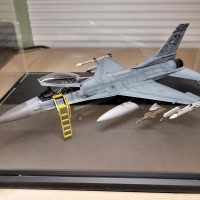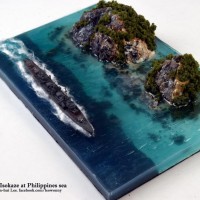Review: Eduard 1/48 P-51B "Salem Representative"
During September, 1943, rumors abounded among pilots in the fighter groups regarding things to come. Word of the first flight of the P-51B in Los Angeles spread through the world of Air Force fighter pilots like wildfire. When Chesley Peterson returned to take command of the 4th Fighter Group, he told the pilots there was a new airplane in the works. Steve Pisanos recalled him saying, “They're coming up with a new fighter that will be far superior to he P-38 and P-47, a kite that can be used for long-range escort.” That rumor became reality on September 26, 1943, when Pisanos returned from escorting B-17s in northern France. “I taxied into the dispersal area only to find a P-51 Mustang with a four-bladed propeller parked on the grass across from my stall.” Pisanos was familiar with the Allison-powered RAF Mustang I, having flown one for 40 hours in OTU training and then another 40 operational hours with 268 Squadron before he came to 71 Eagle Squadron. He met the pilot, Captain Jack Miller from VIII Fighter Command staff. “He told me it was equipped with a Merlin engine and that it was on loan to our group for the pilots to fly and evaluate it.”
A week later, the Mustang was released for flying. Pisanos recalled, “I was more familiar with the Mustang than anyone else in the group. When Captain Miller saw I had 80 Mustang hours in my logbook, he turned it over to me.” Pisanos found the new airplane to be “everything I hoped it would be.” After checking himself out for 15 minutes, “I dropped down on the deck and decided to make a pass over Debden, clocking some 450 miles per hour. As I passed over, I zoomed up and rolled left and right. Then I did a loop, after which I buzzed the runway a few more times.”
Everyone was interested in the new fighter. Over the next two weeks Don Blakeslee flew it several times, as did Don Gentile, Jim Goodson, Deacon Hively and Duane Beeson. All were effusive in their praise of the flying qualities of the new Mustang. Pisanos recalled, “Everyone was paying attention to the P-51. Those of us with experience in Spitfires talked about how wonderful the airplane would be now that it had a Merlin up front.” The Fourth was unanimous in their verdict: it was the best fighter any had flown.
There was universal dismay in VIII Fighter Command when it was learned the new 354th group - assigned to IX Tactical Air Command! - would be first to get the new Mustang. The problem was in the Pentagon; to officers in Materiel Command who had no knowledge of operational reality, the Merlin-powered Mustang was declared a “tactical fighter” because both the RAF and USAAF had decided the earlier, Allison-powered Mustangs would be used in tactical roles. The decision to send the Mustang to the Ninth Air Force was based on bureaucratic precedent, if it was based on anything. When the 363rd group - also in IX TAC - was named number two and the newly-arrived 357th group was given the P-51B and also assigned to IX TAC, a political earthquake happened at Pine Tree, VIII Air Force HQ.
VIII Fighter Command's General Kepner immediately protested that the Mustang, with a vulnerable liquid-cooled engine and a radiator that only needed one minor-caliber hit to be put out of action, was exactly what was not needed in a ground support mission. For VIII Fighter Command, the P-51B was the solution to the problem they had faced since the command first began flying missions - with two drop tanks, a P-51B could reach Berlin, and tests between P-51Bs and captured Bf-109s and Fw-190s demonstrated the Mustang was competitive in ways the P-47 would never be.
One of the first decisions General Dwight Eisenhower made after his arrival in England as Supreme Commander, Allied Expeditionary Forces (SHEAF), was to transfer the 357th to VIII Fighter Command, while IX TAC got the P-47-equipped 358th Fighter Group. All further P-51Bs arriving in Europe would re-equip VIII FC groups. It was a decision that changed the air war and insured the Normandy Invasion would happen.
Ralph Hofer:
Ralph Kidd Hofer joined the RCAF on a lark. A native of Salem, Missouri, Hofer was an outstanding athlete, being especially adept at football and boxing, which he had taken up professionally. Visiting Detroit for a boxing match, he decided to visit Canada. Crossing the bridge afoot, the immigration officer at the border assumed he was another would-be recruit and sent him to the RCAF recruiting office. Though he had no interest in airplanes or flying, the enthusiasm of the other Americans convinced him to enlist. He demonstrated real skill during flight training; shortly after arriving in England he transferred to the USAAF. Once at Debden,he was assigned to the 334th squadron.
The mission of October 8, 1943 was memorable to the Fourth; Duane Beeson scored two victories to become the group's first ace. Jim Clark led the 334th squadron with Ralph Hofer flying his first mission as Clark's wingman. They met the bombers over Tessel Island off the Dutch coast. Steve Pisanos, Clark's element leader, remembered, “We immediately dropped our tanks and took up our positions over the well-spread-out bomber formation. Our squadron was assigned to cover the rear group of some 60 B-17s.” They had just taken station over the bombers when Clark spotted 30 Bf-109s to the south. “At first we thought they were after the bombers, but we soon realized we had been duped. Fifteen of them ignored the bombers and went straight for us. Their plan was to break up the escort and open the door for the rest to go after the B-17s. As they got in range, Captain Clark called ‘Pectin Squadron - break hard. Now!'”
Clark and Hofer broke right while Pisanos and his wingman broke left. Hofer followed Clark while he shot down a Bf-109, then spotted another P-47 under attack. Without hesitation, he winged over and shot down Unteroffizier Franz Effenberger of I./JG 3. Unfortunately, he was too late to save the other pilot, who crashed to his death in the Zuider Zee. Back at Debden, Hofer performed a victory roll and on landing told his crew about shooting down the Fw-190. Other pilots were skeptical until that evening when his gun camera film confirmed the victory. Ralph Hofer had shot down an enemy plane on his first mission and would soon become one of the most memorable characters in a unit full of them, known as the most completely undisciplined pilot in the unit.
Hoefer didn't score his second victory until February 6, 1944, when t Fourth excorted bombers to Romilly and the Luftwaffe appeared in force, with 20 enemy fighters attacking the bombers repeatedly. Hofer shot down a Bf-109G. On February 14, each of the three squadrons received a P-51B. Blakeslee informed the pilots he expected all to check out in the Mustang between combat missions.
On March 18, 700 bombers attacked Berlin. The Luftwaffe rose in force and it was the first time VIII Fighter Command recorded over 100 enemy fighters destroyed. The Fourth had been grounded for three days while all the P-51Bs were equipped with British spark plugs in an attempt to cure the run of engine problems they had during the first two weeks of flying missions with the Mustang. Shortly after t he took station on the bombers, Jim Clark spotted seven Bf-110s attacking the formation. Clark found his guns wouldn't fire, and told wingman Hofer to take over. “I attacked two Me-110s that jettisoned their rockets and dove for the clouds. I followed one - the rear gunner kept firing and hit my prop. I fired and saw strikes, followed by an explosion when it nosed over at 300 feet and crashed.” Hofer pulled out of his dive 20 feet above his crashed victim.
On May 8, Hofer scored his tenth victory; the enemy pilot bailed out so close to him he could see the man's uniform in detail.
Hofer made history on June 11, 1944, when he became the first Allied fighter to land in Normandy, putting down at an advanced stripafter his oil system was damaged by flak during a strafing attack. When he returned to Debden the next day, e brought a German helmet and a German language edition of “Mein Kampf” he'd bartered from GIs.
On June 21, the Fourth escorted the first Operation Frantic mission to the Soviet Union. Hofer got separated from the group and landed at Kiev; after close interrogation by the Soviets, he flew over to Poltava the next day. On June 29, he and three other pilots who had remained at Poltava with mechanical problems when the group departed for Italy, took off to Italy. Hofer went off on his own again, got lost, and was finally brought to Malta by a flight of RAF Spitfires he hooked up with. He flew up to Lucera the next day. His “screwball” reputation had worn thin by now. Deacon Hively had taken away his personal P-51B “Salem Representative” before the shuttle mission when he refused to get his shots for the trip.
Kidd Hofer was lost on July 4, 1944, when he once again got separated from the group on a sweep to Budapest. For many years, it was thought he was one of the four P-51s Erich Hartmann claimed. The truth only came out in 2003. Hofer's wingman, George Stanford, ran out of gas and crashed in Yugoslavia on the return. Hofer made a low pass to check on Stanford, then evaded a Bf-109 that showed up. Leaving Yugoslavia, he spotted planes on the Mostar-Sud airfield and made a strafing run. Flak got his engine and he crashed to his death. His body was disinterred from the grave the Germans dug for him and he was reburied in the VA cemetery in St. Louis, Missouri.
The Kit:
Eduard's announcement last fall that they would produce a P-51B/C kit to the same quality level as their outstanding P-51D series electrified the hobby. The kits began arriving - as the Royal Class - in mid-April.
Eduard fulfilled its promise. Their new kit is definitive.
Those familiar with the Tamiya P-51B will be surprised to find out how many detail parts there are in the new kit, including the first accurate portrayal of the Malcolm Hood and its fittings. The cockpit - a real failure in the Tamiya kit - is completely accurate. Surface detail is the equal of the P-51D. Importantly, Eduard learned from the D-model kits and has changed certain parts to get rid of the earlier “fiddliness” of the D models - most particularly, the attachment of wing subassembly to fuselage subassembly has been simplified and the two come together without problems.
The Royal Class kit is now sold out. Late May will see the release of the D-Day Mustangs Combo kit, with two kits and decals for ten well-known VIII Fighter Command P-51Bs, the majority of which have not appeared as markings options before in kits or aftermarket sheets. The Overtrees kits are now available, which brings the kit inside the budgets of many modelers who still have the many aftermarket sheets made for the Tamiya kit - all of which will fit perfectly on this kit. Eduard will also release several other Limited Release Profipack kits in coming months.
Construction:
This is definitely a kit where you will want to study and then follow the instructions. This is particularly the case with the cockpit assembly.
After several aborted frustrating attempts here, I ended up taking the cockpit side panels off and attaching them to the cockpit floor after the seat, tank, radios and other gear had been installed. This is because the one “fiddly” item of assembly is getting the main cockpit assembly to fit as needed to the side panels. Once I did this, everything came together easily and the deep purple atmosphere over the workbench quickly dissipated. The rest of the fuselage assembly came together the same way the P-51D kit does.
The wing assembles the same as the P-51D wing, with the exception that you do not need to attach the “roof” of the wheel well to the bottom of the cockpit floor and cut off the pesky attachment tang that gets in the way of an easy assembly of the D-model kit.
The wing sub-assembly and fuselage sub-assembly came together without even a slight problem. Be sure to study the instructions for the wing and insure you get all the new detail parts assembled correctly.
The kit provides both the “coffin lid” canopy with open and closed options, as well as the Malcom Hood, also with open and closed options.
These parts are very clear, and the unused option - coffin lid or Malcolm Hood - can be used with Accurate Miniatures P-51 kits (I checked), with the fuselage modified to take the windshield, which is now part of the cowling, avoiding that poor joint one seems to always get with both the Tamiya and A-M kits.
An afternoon's effort saw the kit assembled. I let it set up overnight and proceeded to paint it.
Painting:
I chose to do Ralph Hofer's “Salem Representative,” and also decided to put on the full D-Day stripes shown in a good-quality photo of the airplane, in honor of the coming 80th Anniversary of D-Day. Studying the photo reveals that these stripes were not nice and neat - they were the slam-bam-thank-you-ma'am version of D-Day stripes. I decided to try and reproduce them.
I first applied a thinned coat of XF-2 Flat White over the areas of the stripes, then masked off the white areas in the uneven manner shown in the photo. After shooting the black stripes, I masked off the stripes and proceeded to paint the airframe. I applied X-7 “Red” for the nose and masked that off, then painted the upper cowling with Gunze “Olive Drab 1" since the airplane originally came off the production line without camouflage paint. I applied XF-82 “RAF Dark Green” for the upper surface camouflage.
All that was masked off and then I applied the Mr Color Super Metallics. Eduard has gotten the message on these excellent paints and their callouts for use of the various shades are keyed to the stock number of the Super Metallic paints. I applied “Super Duralumin” to the fuselage and lower surface of the horizontal stabilizer and vertical fin, underside of the flaps and ailerons, and the gear doors, with the paint thinned 50-50 with Mr Color Self-Leveling Thinner 400.
I then used Tamiya Lacquer “Gloss Aluminum” thinned 40 (paint) 60 (leveling thinner) for the outer lower wing surface; this resulted in a “flatter” surface finish, which closely resembles the lacquer finish of the wings on the real thing. I used Tamiya“Silver” for the area of the wing tanks inboard of the D-Day stripes, and “Super Titanium” mixed 50-50 with Tamiya “Gun Metal” for the cowling panels above and below the exhausts.
When I unmasked the model, I went over the white areas of the D-Day stripes with XF-2 Flat White thinned 50-50 and applied with a brush to get the final “ragged look” of those stripes. I applied Micro-sol Clear Flat over the camouflage and stripes to protect them.
Decals:
I used Fundekals US National Insignia, and the kit deals for the rest of the markings, to finish “Salem Representive.” One of my other aftermarket sheets had decal “white sidewalls” which I used on the wheels.
Final assembly:
I attached the landing gear, and the Malcolm Hood in the open position and called things completed.
Overall:
Definitely the best P-51B in any scale. I like this kit as much as I like Eduard's P-51Ds. There will definitely be more of these great kits ending up as models in my collection. Recommended for modelers willing to take the revolutionary step of actually following the instructions, since they are not “somebody's opinion.”


















Interesting history, Tom, and some good tips on building the kit.
Great build and write up Tom. The extra attention paid to the invasion stripes is noticable, they look quite realistic. Well done!
Looks very good. Eduard seems to have knocked another one out of the park.
The one area about the B (on both the Tam and AM kits) that drives me nuts is the section on the top of the fuselage where the windows go just behind the cockpit. Did Eduard fix that?
I didn't have any problem with them.
Looking forward to this! Thanks for the tips.
Excellent build and ditto article, Tom!
Very interesting information and a great building.
Brilliant work Tom. You say it's the best P.51B in any scale. How would it compare to the Arma Hobby kit in 1/72?
The Arma kit is #2. I've now built both and the Arma kit was more difficult to get everything inside.
Excellent build Tom ! love those whitewall tires !
Nicely done, Tom
Nice metalwork, Tom! I can’t wait to try the Super Metallics.
A fantastic build as usual, Tom @tcinla
Those "handpainted" markings are perfectly done.
Great historical background as well.
Outstanding build and write up...once again. Thanks for the heads up on the cockpit side walls. I saw the change on the cockpit floor/wing join in the instructions and am glad to hear that it fixed that pesky issue. I am really looking forward to building mine. Thanks a bunch.
A great-looking Mustang - finish looks excellent. Another nice project, Tom!
Excellent! Another one to go on my gotta have list!
Thanks again Tom for your fantastic job!
I hope Eduard will release soon a duo combo box with one P-51B and one P-51D 😎
Fantastic! Great Invasion stripes!
Great article, currently have this on my bench. Thanks for the cockpit tip.👍👍